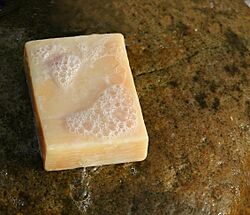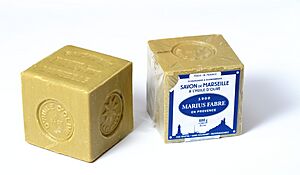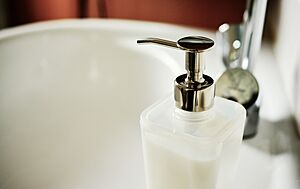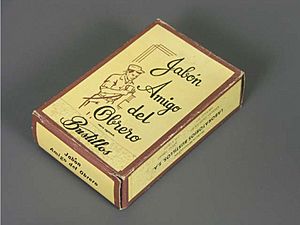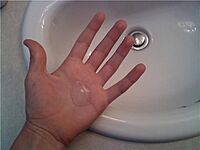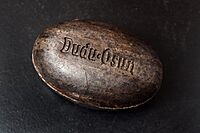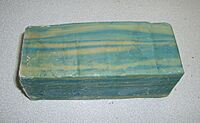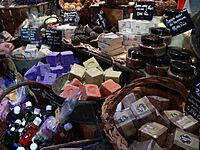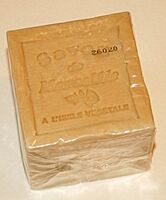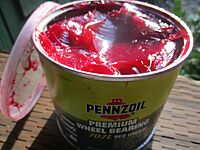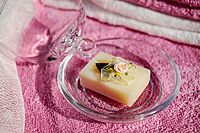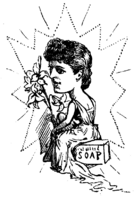Soap facts for kids
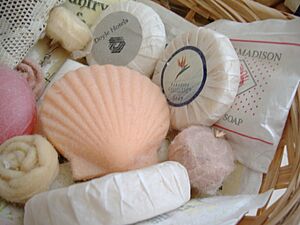
Soap is a special cleaning product that helps us wash away dirt, oil, and germs. It comes in many forms, like bars, liquids, or even foam. Soap is made by mixing fats or oils with a strong substance called lye. This process is called saponification, and it creates the soap we use every day.
In industrial settings, soaps are used as thickeners, components of some lubricants, and precursors to catalysts.
Contents
Why do we need soap?
Soap is essential for keeping us healthy. Here’s why:
- Washing your hands with soap is the best way to remove harmful germs that can make you sick.
- Regular handwashing with soap can reduce the risk of diseases like diarrhea and respiratory infections.
- Soap isn’t just for hands—it’s used to clean dishes, clothes, and even toys.
How does soap work?
Soap is a surfactant, which means it helps water mix with oil and dirt. Here’s how it works:
- Breaks down oil: Soap molecules have two ends—one that loves water (hydrophilic) and one that loves oil (hydrophobic). When you rub soap on your hands, the oil-loving end grabs onto dirt and oil, while the water-loving end sticks to water.
- Lifts germs: Germs often hide in the oil on your skin. Soap lifts this oil, along with the germs, so they can be washed away with water.
- Creates foam: When you rub soap with water, it creates foam, which helps spread the soap over your hands and clean every nook and cranny.
How do you make soap?
You only need a few basic ingredients to make soap:
- Fats or oils: These can be animal fats (like tallow or lard) or vegetable oils (like olive oil, coconut oil, or palm oil). Different fats and oils create different qualities in the soap.
- Alkali: This is a chemical that reacts with the fats or oils to create soap. The most common alkali used in soapmaking is lye (sodium hydroxide for bar soap and potassium hydroxide for liquid soap). Remember that lye is a strong chemical and must be handled with care by adults only!
- Water: Water is used to dissolve the lye and help the saponification process.
Here's a simplified version of how soap is made:
1. Mixing the lye solution: An adult carefully mixes the lye with water. This creates a lye solution. The mixture gets very hot, so it's important to be cautious!
2. Melting the fats or oils: The fats or oils are melted in a separate container.
3. Combining the ingredients: The lye solution is slowly added to the melted fats or oils while stirring constantly.
4. Saponification: As the lye solution and fats/oils mix, the saponification process begins. This can take some time, and the mixture will start to thicken.
5. Adding Extras (optional): At this point, you can add things like essential oils for fragrance, herbs for color and texture, or other additives to customize your soap.
6. Pouring into a mold: The soap mixture is poured into a mold (like a box or container) to set.
7. Curing: The soap needs to cure for several weeks. During this time, the saponification process continues, and the soap becomes milder and harder.
Types of soap
There are many different types of soap, each with its own unique qualities:
- Bar soap: This is the most common type of soap. It's solid and comes in many different shapes, sizes, and fragrances.
- Liquid soap: Liquid soap is a convenient option for handwashing and showering. It's often dispensed from a pump bottle.
- Glycerin soap: Glycerin is a natural byproduct of soapmaking. Glycerin soap is known for being gentle and moisturizing.
- Castile soap: Castile soap is traditionally made with olive oil. It's a mild and versatile soap that can be used for many purposes.
- Laundry soap: Laundry soap is specially formulated to clean clothes. It's often more concentrated than other types of soap.
Interesting facts about soap
- Soap has been around for thousands of years!The earliest evidence of soap-making dates back to ancient Babylon around 2800 BC.
- The ancient Egyptians used soap as a medicine and combined animal fats or vegetable oils with a soda ash substance called trona to create their soaps.
- A detergent similar to soap was manufactured in ancient China from the seeds of Gleditsia sinensis.
- In Europe, soap in the 9th century was produced from animal fats and had an unpleasant smell. This changed when olive oil began to be used in soap formulas instead, after which much of Europe's soap production moved to the Mediterranean olive-growing regions.
- Hard toilet soap was introduced to Europe by Arabs.
- Liquid soap was not invented until the nineteenth century; in 1865, William Sheppard patented a liquid version of soap.
- Soap can create bubbles because it reduces the surface tension of water, allowing it to stretch and form thin films.
- In the past, soap was a luxury item that only wealthy people could afford.
- During World War I and World War II, there were soap shortages because fats and oils were needed for the war effort.
-
A 1922 magazine advertisement for Palmolive Soap
How to use soap properly
- Wet your hands: Start by wetting your hands with clean water.
- Apply soap: Rub soap all over your hands, including between your fingers and under your nails.
- Scrub for 20 Seconds.
- Rinse thoroughly: Wash off all the soap with running water.
- Dry your hands: Use a clean towel to dry your hands completely.
Gallery
-
Handmade soaps sold at a shop in Hyères, France
-
Modern soap shop in Tübingen (2019)
-
The lye is dissolved in water.
-
Caricature of Lillie Langtry, from Punch, Christmas 1890: The soap box on which she sits reflects her endorsements of cosmetics and soaps.
-
Structure of a micelle, a cell-like structure formed by the aggregation of soap subunits (such as sodium stearate): The exterior of the micelle is hydrophilic (attracted to water) and the interior is lipophilic (attracted to oils).
See also
 In Spanish: Jabón para niños
In Spanish: Jabón para niños
Types of soap
- African black soap, popular in West Africa
- Aleppo soap, popular in Syria
- Castile soap, popular in Spain
- Marseille soap, popular in France
- Moroccan black soap, popular in Morocco
- Nabulsi soap, popular in the West Bank
- Saltwater soap, used to wash in seawater
- Shaving soap, used for shaving
- Vegan soap, made without use of animal byproducts
- Antibiotic misuse
- Dishwashing soap
- Foam
- List of cleaning products
- Hand washing
- Palm oil
- Soap bubble
- Soap dish
- Soap dispenser
- Soap plant
- Soap substitute
- Soapwort
- Shampoo
- Shower gel
- Toothpaste


